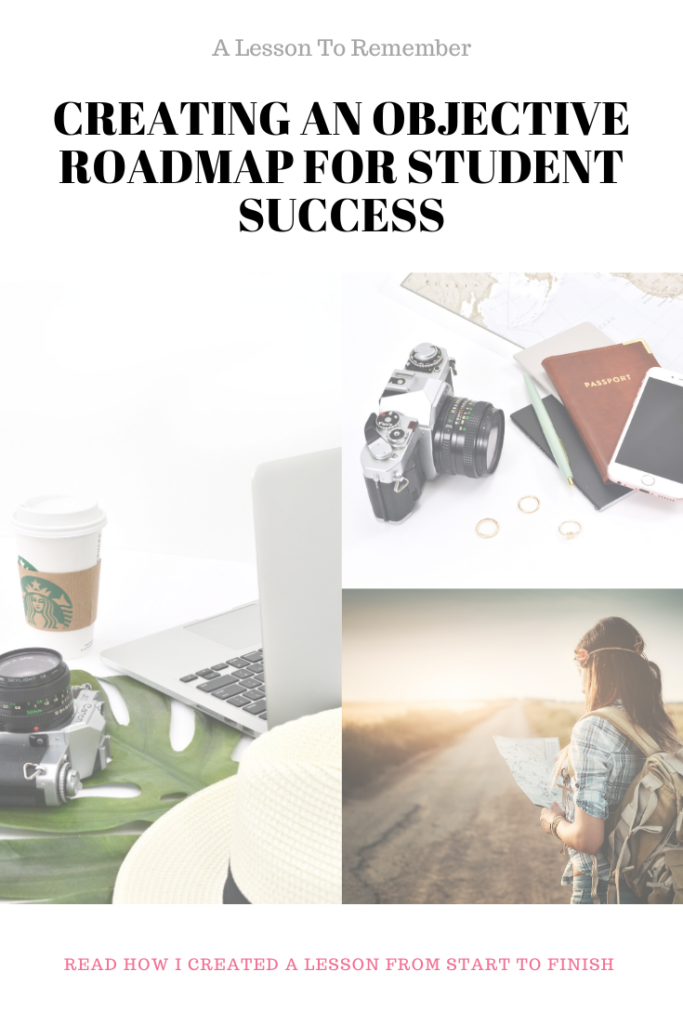
Have you ever driven to a new city without a GPS or map? I would not suggest teaching without a “roadmap” or a lesson plan. Recently, I was traveling three hours away, and I was riding with one of my sorority sisters, Jawana. She is a supervisor of a satellite children’s mental facility, where she supervises social workers and therapists. During our trip, I was recanting my school year and some of the feedback I was receiving from my evaluator. She looked at me and said, “It sounds like you need to focus more. What is the purpose of the class? What do students need to learn to be successful? What goals or objectives do you want students to learn?” It was during that time that I began to reflect and really think about the objectives I wanted students to learn. By the end of our trip, I had created two worksheets, one for my students and one for me to follow.
Step One-Creating a Roadmap for Learning
Once I opened my computer, I created an objective printable for me. I listed the questions: What are the steps to accomplish the objective? What is the purpose of this lesson? What do I want the students to learn from this lesson? How does this lesson relate to the student’s life experience? For my reading lab classes, I want to teach them the skills to be successful within their language arts classes and other courses. I wanted them to understand the common core standards and perform the skill each standard requires. With the assistance of MindPlay (a computer reading program), I want students to increase their grade level by one and a half grade levels within one school year. How will they accomplish each standard? I will have students practice each standard skill and understand the vocabulary of each standard.

Step Two- Designing a Vocabulary List from Ohio State Standards Reading Informational Text
When Jawana asked if the students could restate the definition of cite or textual evidence, I could not give her a direct answer. I assumed, because they were in 7th and 8th grade, they could restate the definition, but I was not sure. I created a worksheet that had six vocabulary words from the Ohio state standards reading for informational text. The worksheet included questions about the words they found challenging, a section to deconstruct the two standards in their own words, six boxes to draw a nonlinguistic representation of the vocabulary, and question ideas for each standard. I quickly learned that students did not know the meaning of many of the vocabulary words. They were so engaged when I introduced the standard vocabulary words because they longed to know the meaning. The vocabulary words included cite, textual evidence, explicitly, examples, details, central ideas, and inferences. I was in awe that students did not know what cite meant-I used that word all the time in my objective
Step Three-I Used the “Learning Window” from the book Tools for Classroom Instruction that Works
While at work, I went to the website for Tools for Classroom Instruction that Works and saw the tool “Learning Window”, which is a form for setting objectives. This form has five boxes, and each box focuses on an area. “What will students need to know? What habit of mind will I try to foster? What will my students need to understand? What will my students need to be able to do? What terms will students need to know?” I purposely and intentionally filled out each box for the lesson’s unit. Filling out this form took time because I had to think and focus on student learning. I want them to know the two state standards. They need to know how to identify and cite pieces of textual evidence to explain why an author wrote the article and identify the central ideas from an article. They need to know the words cite, identity, textual evidence, and central idea.

Outcomes for Having a Roadmap
The first week using the worksheet was positive. Students were asking questions, engaging in discussions of the vocabulary words, and having epiphanies. During small groups, we discussed the vocabulary words and the skills the students had to complete for each standard. The students had to “Use three examples of textual evidence to show why the author wrote this piece,” and “What central ideas are revealed in the article?” Students read articles on their reading level, and they had to answer the questions. Students that used purposeful annotation were able to give more correct answers compared to students that did not annotate the text. I encouraged annotating the text, and each student had a worksheet with metacognitive markers. We discussed each question, I directed the student to the correct answer, and I did a mini think-aloud. Although the students did not earn 100% on the questions, they learned what to expect from the question ideas, and they learned how to search for the answers.
The students’ attitudes were positive, and they were highly motivated. They understood that it would take hard work and practice to get the correct answers, and they were eager to get more answers. I will continue this way of teaching and keep documentation of growth. Within these two weeks, I have witnessed growth in stating the definition of domain-specific vocabulary words and knowing how to identify the skills for the Ohio state content standards. What are your thoughts about having a roadmap for your classes? Do you think about the objectives and organize your classes accordingly? Let me know in the comment section below.





Leave a Reply